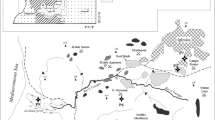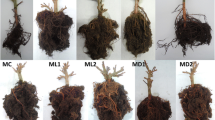Abstract
A field investigation was conducted to understand the root distributions and elemental accumulations of Chinese brake (Pteris vittata L.), an As-hyperaccumulator, grown in soils with a gradient of As concentration near an arsenic sulphide mine. The root distribution was affected not only by the levels of soil As, but also by soil texture. Plants grew better in sandy loam soils than in clay soils. Increases in the ratio of frond biomass to underground biomass were correlated with decreasing soil As concentration. Root densities of the plant decreased from 0–10 cm, 10–20 cm to 20–30 cm in the soil profiles. Most of the roots were concentrated in the upper 0–10 cm layer. Under high As conditions, As concentrations in different tissues followed the trends: pinnae > rhizomes ≈ roots of 0–10 cm > roots of 10–20 cm > roots of 20–30 cm > petioles, however, As concentrations in pinnae were higher than those in rhizomes under low As conditions. The rhizomes and pinnae were the main As pools, storing 75–86% of the total As uptaken by the plants. The rhizome, a `buffer-storage' for plant As, maintained high concentrations of As under high soil As while the pinnae became the most important organ of storing the As under low soil As. Chinese brake might possess the ability of adjusting its As-storage under different soil As levels. The plant can not only hyperaccumulate As from the soils, but also enriched P and Ni from the soils and translocated them to the fronds. It is important to improve the root distribution for phytoremediation of As-contaminated soils using Chinese brake.
Similar content being viewed by others
References
Allinson G, Turoczy N J, Kelsall Y, Allinson M, Stagnitti F, Lloyd S J and Nishikawa M 2000 Mobility of the constituents of chromated copper arsenate in a shallow sandy soil. New Zeal. J. Agr. Res. 43(1), 149–156.
Baker A J M and Brook R R 1989 Terrestrial higher plants which hyperaccumulated metallic elements: A review of their distribution, ecology and phytochemistry. Biorecovery. 1, 81–126.
Baker A J M, McGrath S P, Reeves R D H 2000 Metal hyperaccumulator plants: A review of the ecology and physiology of a biological resource for phytoremediation of metal-polluted soils. InPhytoremediation of Contaminated Soil and Water, Eds. N Terry and G S Bañuelos. pp. 85–107. CRC, USA.
Baker A J M, McGrath S P, Sidoli C M D and Reeves R D H 1994 The possibility of in situ heavy metal decontamination of polluted soils using crops of metal-accumulating Crops. Resour. Conserv. Recy. 11, 41–49.
Baker A J M, Reeves R D H and McGrath S P 1991 In situ decontamination of heavy metal polluted soils using crops of metal-accumulating plants-a feasibility study. InIn Situ Bioreclamation, Eds. R E Hinchee and R F Olfenbuttel. pp. 600–605. Butterworth-Heinemann, Boston.
Blaylock M J 2000 Field demonstrations of phytoremediation of lead-contaminated soils. InPhytoremediation of Contaminated Soil and Water, Eds. N Terry and G S Bañuelos. pp. 1–12. CRC, USA.
Boominathan R and Doran P M 2002 Ni-induced oxidative stress in roots of the Ni hyperaccumulator, Alyssum bertolonii. New Phytol. 156, 205–215.
Brown S L, Chaney R L, Angle J S and Baker A J M 1995 Zinc and cadmium uptake by hyperaccumulator Thlaspi caerulescensand metal tolerant Silene vulgarisgrown on sludge-amended soils. Environ. Sci. Technol. 29, 1581–1585.
Chaney R L, Brown S, Li Y M, Angel J S, Homer F and Green C 1995 Potential use of metal hyperaccumulators. Min. Environ. Manage. 3(3), 9–11.
Chen T-B, Liu G-L, Xie K-Y and Gan S-W 1992 Soil and crop arsenic contents in arsenic-toxic area in Southern China's Hunan Province and the critical contents of soil arsenic to crop safety. Soil and Fertilizer 2, 1–4 (in Chinese).
Chen T-B, Fan Z-L, Lei M, Huang Z-C and Wei C-Y 2002a Effect of phosphorus on arsenic uptake by As-hyperaccumulator Pteris vittataL. and its implication. Chinese Sci. Bull. 47(15), 1156–1159.
Chen T-B, Wei C-Y, Huang Z-C, Huang Q-F, Lu Q-G and Fan Z-L 2002b Arsenic hyperaccumulator Pteris vittataL. and its arsenic accumulation. Chinese Sci. Bull. 47(11), 902–903.
Colbourn P, Alloway B J and Thornton I 1975 Arsenic and heavy metals in soils associated with regional geochemical anomalies in South-West England. Sci. Total Environ. 4, 359–363.
Davis A, Sherwin K, Ditmars R and Hoenke K A 2001 An analysis of soil arsenic records of decision. Environ. Sci. Technol. 35, 2401–2406.
Editorial Committee for Flora of the Chinese Academy of Sciences (ECFCAS) 1990 Flora of China (Vol. 3, Sect. 1).Science Press, Beijing. pp. 15–87 (in Chinese).
Fergusson J E 1989The heavy elements: Chemistry, environmental impacts and health effects. p. 614. Pergamon Press, Oxford.
Fowler B A 1983 Biological and Environment Effects of Arsenic. Elsevier, Amsterdam, New York.
Galasso J L, Siegel F R and Kravitz J H 2000 Heavy metals in Eight 1965 cores from the Novaya Zemlya Trough, Kara Sea, Russian Arctic. Mar. Pollut. Bull. 140(10), 839–852.
Kalbitz K and Wennrich R 1998 Mobilization of heavy metals and arsenic in polluted wetland soils and its dependence on dissolved organic matter. Sci. Total Environ. 209, 27–39.
Killingbeck K T, Hammen-Winn S L and Vecchio P G 2002 Nutrient resorption efficiency and proficiency in fronds and trophopods of a winter-deciduous fern, Dennstaedtia punctilobula. Int. J. Plant Sci. 163(1), 99–105.
Liao X-Y, Chen T-B, Xiao X-Y, Huang Z-C, An Z-Z, Mo L-Y, Li W-X, Chen H and Zheng Y-M 2003 Spatial distribution characteristics of arsenic in contaminated paddy soils. Geographical Research 22(5), 635–643 (in Chinese with English abstract).
Liao X-Y, Chen T-B, Xie H and Xiao X-Y 2004 Effect of application of P fertilizer on efficiency of As removal in contaminated soil using phytoremediation: Field demonstration. Acta Scientiae Circumstantiae 24(3) (in Chinese with English abstract) (In press).
Lisk J 1994 Persistence phytotoxicology, and management of arsenic, lead, and mercury residue in old orchard soils of New York State. Chemosphere 19(6), 1361–1367.
Ma L Q, Komar K M, Tu C, Zhang W, Cai Y and Kennelley E D 2001 A fern that hyperaccumulates arsenic. Nature (London). 409, 579.
Macnair M R and Baker A J M 1994 Metal-tolerant plants: An evolutionary perspective. InPlants and the Chemical Elements, Ed. M E Jarago. pp. 67–85. VCH, Weinheim, Germany.
Mench M, Bussière S, Boisson J, Castaing E, Vangronsveld J, Ruttens A, Koe T D, Bleeker P, Assunção A and Manceau A 2003 Progress in remediation and revegetation of the barren Jales gold mine spoil after in situ treatments. Plant Soil. 249(1), 187–202.
Murphy E A and Aucott M 1998 An assessment of the amounts of arsenical pesticides use historically in geographic area. Sci. Total Environ. 218, 89–101.
Nedelkoska T V and Doran P M 2001 Hyperaccumulation of nickel by hairy roots of Alyssum species: Comparison with whole regenerated plants. Biotechnol. Prog. 17, 752–759.
Page A L, Miller R H and Keeney D R 1982 Methods of Soil Analysis, Part 2: Chemical and Microbiological Properties, Second Edition. pp. 385–430. American Society of Agronomy, Inc., Madison, Wisconsin USA.
Phillips D J H 1990 Arsenic in aquatic organisms: A review, emphasizing chemical speciation. Aquat. Toxicol. 16, 151–186.
Salt D E, Blaylock M, Kumar P B A N, Dushenkov V, Ensley B D, Chet L and Raskin L 1995 Phytoremediation: A novel strategy for the removal of toxic metals from the environment using plants. Biotechnology 13, 468–474.
Schnoor J L, Licht L A, McCutcheon S C, Wolfe N L and Carreira L H 1995 Phytoremediation of organic and nutrient contaminant. Environ. Sci. Technol. 29, 318–323.
Smith A H, Hopenhayn-Rich C, Bates M N, George H M, Hertz-Picciotto I, Duggan H M, Wood R, Kosnett M J and Smith M T 1992 Cancer risk from arsenic in drinking water. Environ. Health Persp. 103, 13–15.
Tack F M G, Verloo M G, Vanmechelen M and Van Ranst E 1997Baseline concentration levels of trace elements as a function of clay and organic carbon contents in soils in Flanders (Belgium). Sci. Total Environ. 201, 113–123.
Wang Z, He H, Yan Y, Wu C, Yan Y and Gao X 1999 Arsenic exposure of residents in areas near Shimen Arsenic Mine. Journal of Hygiene Research 28(1), 12–14 (in Chinese).
Wei C-Y and Chen T-B 2002 The ecological and chemical characteristics of plants in the areas of high arsenic levels. Acta Phytoecologica Sinica 26(9), 695–700 (in Chinese with English abstract).
Wei C-Y, Chen T-B, Huang Z-C and Zhang X-Q 2002 Cretan brake (Pteris creticaL.): An arsenic accumulating plant. Acta Ecologica Sinica 22, 777–778 (in Chinese with English abstract).
Wei C-Y, Chen T-B, Huang Z-C and Zhang X-Q 2003 Arsenic accumulation by two brake ferns in south China. Chemosphere (in revision).
Wenzel W W, Bunkowskia M, Puschenreitera Mand Horakb O 2003 Rhizosphere characteristics of indigenously growing nickel hyperaccumulator and excluder plants on serpentine soil. Environ. Pollut. 123, 131–138.
Rights and permissions
About this article
Cite this article
Liao, XY., Chen, TB., Lei, M. et al. Root distributions and elemental accumulations of Chinese brake (Pteris vittata L.) from As-contaminated soils. Plant and Soil 261, 109–116 (2004). https://doi.org/10.1023/B:PLSO.0000035578.24164.fa
Issue Date:
DOI: https://doi.org/10.1023/B:PLSO.0000035578.24164.fa




